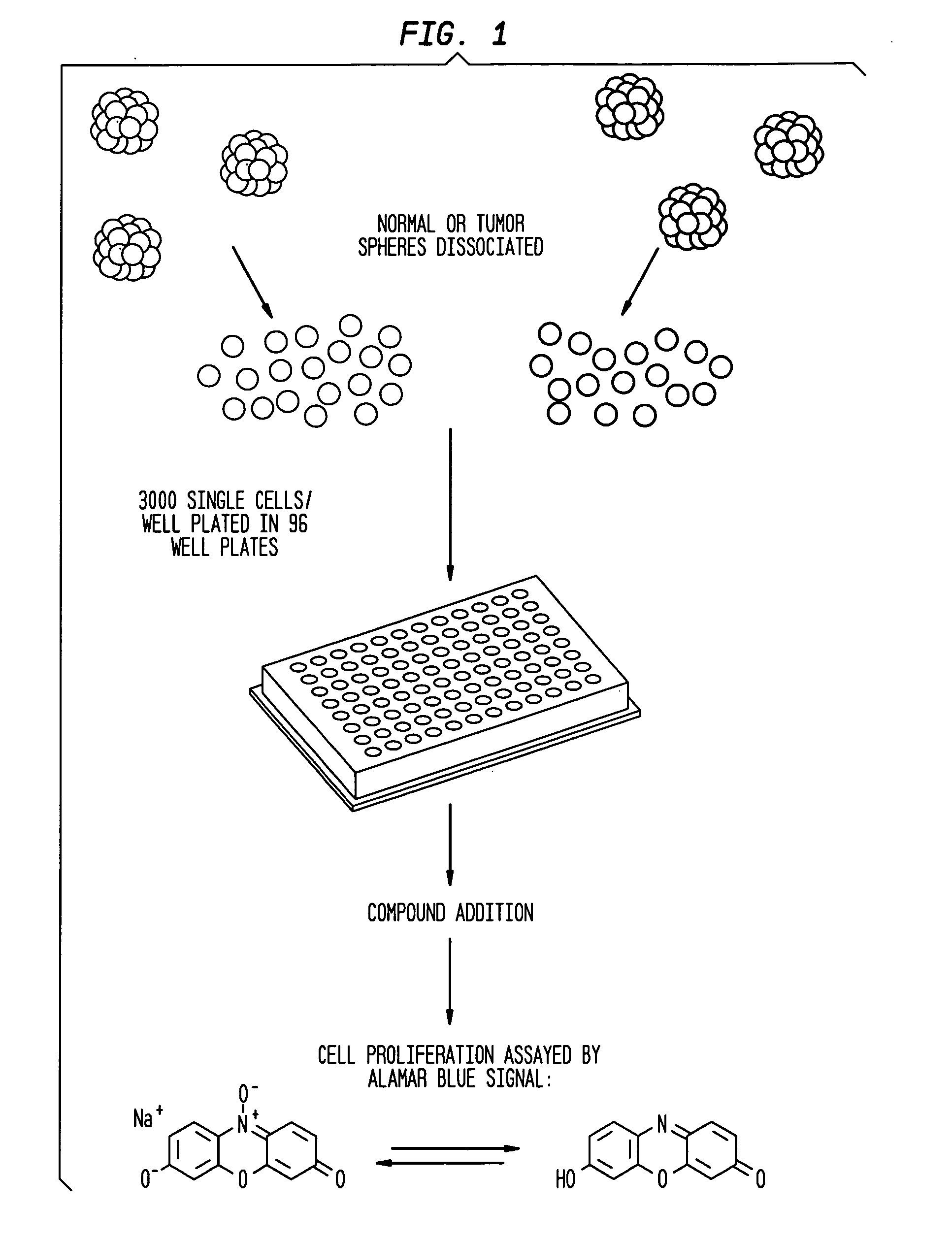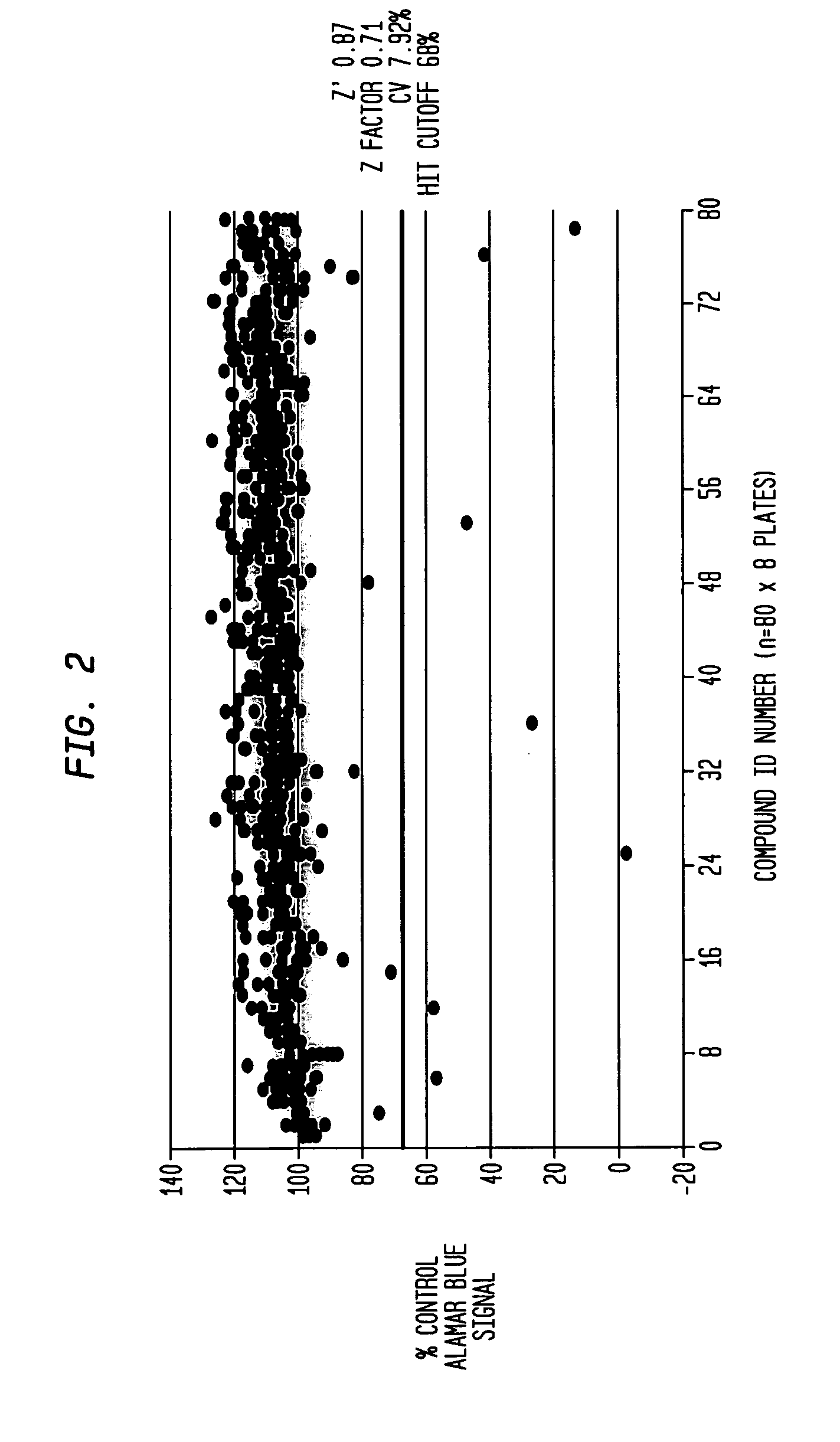Novel chemical entities affecting neuroblastoma tumor-initiating cells
a neuroblastoma and tumor-initiating cell technology, applied in the direction of tumor/cancer cells, plant growth regulators, biocide, etc., can solve the problems of poor survival rate in children with metastatic disease, ineffective conventional cancer therapies, and inability to effectively treat children over one-year-old nb tumors, etc., to reduce the cytotoxicity of non-neuroblastoma tumor-initiating cells, reduce the high mortality rate, and the effect o
- Summary
- Abstract
- Description
- Claims
- Application Information
AI Technical Summary
Benefits of technology
Problems solved by technology
Method used
Image
Examples
example i
Materials and Methods
[0122] The present example provides a description of the screening method used to identify the chemical entities capable of affecting neuroblastoma cells reported in the present series of studies.
[0123] Malignant neuroblastoma (NB) is the most common extra-cranial solid tumor in children. Survival of patients older than 1 year remains less than 30% with conventional therapies. Candidate NB tumor-initiating cells (TICs) were isolated, and it was hypothesized that TICs are related to SKPs (SKin-derived Precursors). Both SKPs and TICs originate from the neural crest, express similar neural crest markers, and differentiate in vitro into similar cell types. The availability of two neural crest stem cell sources, one from the NB tumor and the other from the skin of the same patient, affords us a unique opportunity for therapeutic target discovery.
Study 1 Screen:
Materials and Methods:
[0124] To identify compounds that suppress the growth and survival of neuroblast...
example 2
d Compounds that Affect Normal, NB, or NB and Normal Cells
[0140] The present example provides a description of the screening method used to identify and select chemical entities capable of affecting (i.e., reducing and / or inhibiting) neuroblastoma cells. The screening method is used here with the LOPAC compound collection. (LOPAC library, Sigma).
[0141] Candidate NB tumor-initiating cells (TICs) were isolated. These TICs were used in the screening assay for the identification of these kinds of compounds because they are related to SKPs (SKin-derived Precursors). For example, both SKPs and TICs originate from the neural crest, express similar neural crest markers, and differentiate in vitro into similar cell types. The availability of two neural crest stem cell sources, one from the NB tumor and the other from the skin of the same patient, affords an approach for the therapeutic target discovery provided here.
Materials and Methods:
Methods:
[0142] To identify compounds that specif...
example 3
e Screening Assay Selection Results
[0147] The present example presents the tabulated data obtained with the various chemical library screens conducted.
TABLE 16NBhitNB + FSIC50LibraryNameRepeatedonlyhittest?target / mechanismS10-HYDROXYCAMTOTHECINXXmodified camptothecinL2.3-Dimethoxy-1.4-naphthoquinoneXXROS modulator / Redoxcycling agent used tostudy role of ROSS3-METHYLORSELLINIC ACIDXXAspergillus terreusfungal metabolite;possible antioxidantS4′-XXDEMETHYLEPIPODOPHYLLOTOXINS5alpha-CHOLESTAN-3beta-OL-6-ONEXXCholesterol oxidationproduct; cytotoxic due tooxidative stress orcytoskeleton disruptionS5-AZACYTIDINEXXSACRIFLAVINIUMintercalating agent thatHYDROCHLORIDEinterferes with DNAreplic / transcription;antitumor,antiproliferativeSACRISORCINtopical anti-infectivefrom 1960sSAKLAVINE HYDROCHLORIDEXXXnatural product; anti-infective; relatedstructures have broadactivity against NIHtumor linesPAlexidine dihydrochlorideXXphospholipase inh; oralgingivitis rinseSALEXIDINE HYDROCHLORIDEPAlprostadilv...
PUM
| Property | Measurement | Unit |
|---|---|---|
| chemical compositions | aaaaa | aaaaa |
| Mass screening | aaaaa | aaaaa |
| min-width | aaaaa | aaaaa |
Abstract
Description
Claims
Application Information
 Login to View More
Login to View More - R&D
- Intellectual Property
- Life Sciences
- Materials
- Tech Scout
- Unparalleled Data Quality
- Higher Quality Content
- 60% Fewer Hallucinations
Browse by: Latest US Patents, China's latest patents, Technical Efficacy Thesaurus, Application Domain, Technology Topic, Popular Technical Reports.
© 2025 PatSnap. All rights reserved.Legal|Privacy policy|Modern Slavery Act Transparency Statement|Sitemap|About US| Contact US: help@patsnap.com



